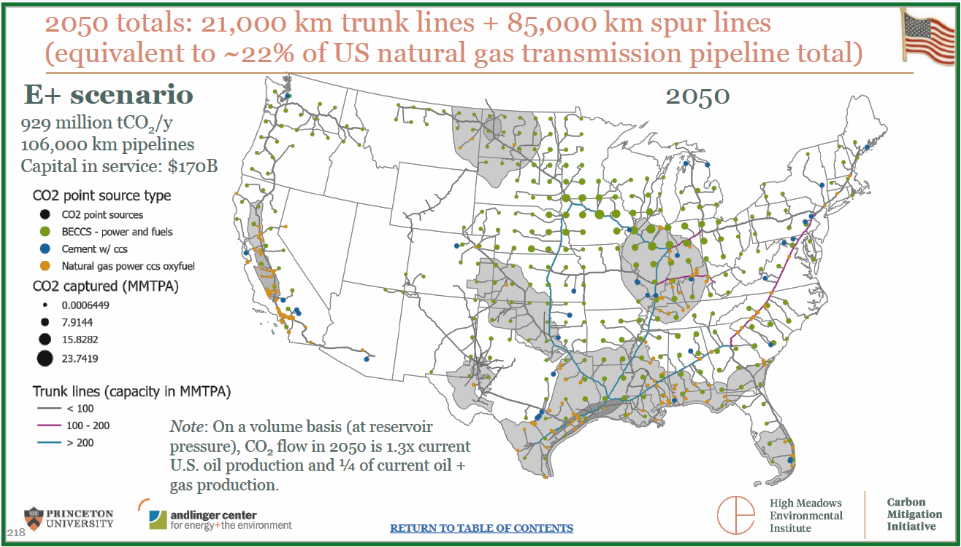In recent years, carbon dioxide (CO2) waste capture and injection, also known as carbon capture and storage (CCS) and carbon capture use and storage (CCUS), has gained momentum as a suggested climate change solution, especially as the United States federal government throws billions of dollars behind it. This unproven technology has been particularly attractive to oil, gas, and petrochemical companies which are trying to stay relevant in a world where we need to drastically cut climate-changing pollution to avoid the worst effects of global warming.
What is CO2 waste capture and injection? There are three main components:
- A certain percentage of CO2 waste is captured at pollution-emitting locations, such as power, ammonia, and hydrogen plants.
- The CO2 waste is transported via pipeline to an injection site.
- The CO2 waste is injected deep underground, either for storage or to force more oil out of existing oil wells, a process called enhanced oil recovery (EOR).

Each step is problematic, so let’s look at them one by one.
- If the idea of capturing emissions from power plants sounds familiar, we only have to look back to the dream of “clean coal,” where proponents promised that they could burn coal and capture the CO2. This failed multiple times. For example, the Mississippi Kemper Clean Coal Plant construction costs ballooned from $2.4 billion to $7.5 billion. This facility never ended up operating and was partially demolished in 2021.
A few more recent examples highlight the false promise of CO2 waste capture and injection. The Petra Nova project in Texas,“mothballed” in 2022, never reached its target of capturing 90% of its CO2 emissions. The appropriately-named Gorgon project in Australia has only been able to capture half of the CO2 they promised.
This brings up an important environmental justice issue. Many of these new CO2 waste capture facilities are associated with petrochemical and natural gas facilities that are located in Black and Indigenous communities that are already overburdened with polluted air, water, and soil. Even if this technology worked, Black, Brown, and Indigenous communities would suffer the effects of any pollution these facilities produced.
- One of the biggest threats is the transportation of CO2 waste from capture site to injection site. CO2 is heavier than oxygen and can displace it, so when exposed to the gas, people and pets can experience rapid breathing, confusion, elevated blood pressure, and even death by suffocation. This made headlines when a CO2 pipeline burst near the town of Satartia, Mississippi. The pipeline, owned by the company Denbury, is used to transport CO2 waste to oil wells for EOR but, on February 22, 2020, it catastrophically ruptured. The escaped CO2 traveled approximately one mile into the small town, where 49 members of the community were hospitalized.
“We got lucky,” said Yazoo County Emergency Management Agency director Jack Willingham, who oversaw the rescue effort. “If the wind blew the other way, if it’d been later when people were sleeping, we would have had deaths.”
Currently, there are relatively few CO2 pipelines, but if fossil fuel companies have their way, CO2 waste capture will bring thousands of miles of pipelines across the country, threatening hundreds of communities with deadly CO2 pipeline ruptures. As the maps below show, this would have a massive impact on the entire country.


- Finally, we have the injection of CO2 waste. Much of itwill be used for enhanced oil recovery, a misleading way to promote more oil extraction. This contradicts the goal of reducing oil dependency and reducing the extraction of more carbon from the ground, yet CO2 waste injection is promoted as a climate-friendly solution by the fossil fuel industry.
Storing CO2 waste underground also has potential risks, including blowouts of abandoned oil and gas wells, groundwater contamination, increased earthquakes, shifting ground damaging vital infrastructure, and increased wetland loss.
CO2 waste capture and injection is a false solution to the climate crisis, but this harmful industry is strongly supported by petrochemical companies and politicians in the Gulf South. Denbury (the company that brought us the Satartia disaster) alone is proposing to dramatically increase their pipeline infrastructure by hundreds of miles.
Despite the risks, the federal government is pumping billions of dollars into CO2 waste capture and injection. The Bipartisan Infrastructure Law (2021) has dedicated $12.1 billion to promote the practice, and the Inflation Reduction Act (2022) has substantially increased the federal subsidy for CO2 waste capture, which will result in billions of taxpayer dollars going to the oil, gas, and petrochemical industries.
The good news is that there is still time to fight these projects, and we have seen a groundswell of opposition to these projects like the proposed Air Products ammonia plant in Cancer Alley and Lake Maurepas in Louisiana. People know this is a false solution and a handout to big oil. It is time for our politicians to catch up and promote real solutions to the climate crisis.
—
Matt Rota is Healthy Gulf’s Senior Policy Director. He and his team advocate for science-based policies and environmental enforcement that protect Gulf communities.
